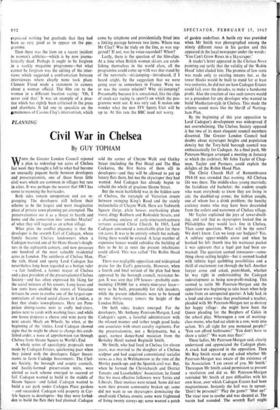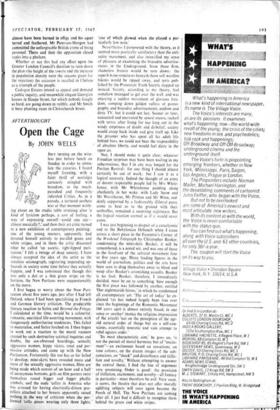Civil War in Chelsea
PLANNING
By GUY TOPHAM
WHEN the Greater London Council rejected a plan to redevelop ten acres of Chelsea last week they brought a lull to what had become an unusually piquant battle between developers and preservationists, one of those fierce little civil wars which are common in villages but rare in cities. It was perhaps the nearest that SW3 has come to manning the barricades.
Both sides remain unrepentant and are re- grouping. The developers still believe their scheme to be the largest and most imaginative piece of private town planning yet attempted. The preservationists see it as a threat to hearth and home and the conversion into 'another Mayfair' of what they still regard as an urban village.
What gives the conflict piquancy is that the developer is the seventh Earl of Cadogan, whose family became Cheisea landowners when a Cadogan married one of Sir Hans Sloane's daugh- ters in the eighteenth century, and now possesses one hundred of the most valuable residential acres in London. The antithesis of Chelsea Man, the rich, bland and sporty Lord Cadogan has nevertheless long been regarded as a benign ruler —a fair landlord, a former mayor of Chelsea and a past president of the preservationist Chelsea Society—and has often expressed his liking for the social mixture of his tenants. Long leases and low rents have enabled the streets of Victorian terraces he owns to evolve one of the largest con- centrations of mixed social classes in London, a feat that eludes town-planners. Here are Pom- peiian dining-rooms next to stuffy bed-sitters, patios next to yards with washing lines; and while one house prepares a cheese and wine party the next awaits Meals on Wheels. So when, at the beginning of the 'sixties, Lord Cadogan showed signs that he might be about to change this estab- lished order, a wave of apprehension ran through Chelsea from Sloane Square to World's End.
A whole series of apocalyptic proposals were made by Cadogan Estates, quickening pace when they joined with the developers Edger Invest- ments to form Cadedge Investments. The Chel- sea Society, the borough and county councils, and hastily-formed preservation units, were alerted as each scheme emerged to succeed or fail. Cadogan wanted to build in the middle of Sloane Square—and failed. Cadogan wanted to build a car park under Cadogan Place gardens —and succeeded. Cadogan sold property in Car- lyle Square to developers—but they were forbid- den to build the flats they had planned. Cadogan sold the corner of Cheyne Walk and Oakley Street (including the Pier Hotel and The Blue Cockatoo, the first bistro of them all) to developers—and they will be allowed to put up luxury flats there, but not the skyscraper they had wanted. And Cadogan has already begun to rebuild the whole of gracious Sloane Street.
But the main battlefield was in the hidden core of Chelsea, the rectangle of Victorian streets between swinging King's Road and the stately melancholia of Cheyne Walk. Here are Tedworth Square (large, plain houses overlooking plane trees), dingy Redburn and Redesdale Streets, and a charming enclave of early-nineteenth-century terraces around Christ Church. In 1965, Lord Cadogan announced a remarkable plan for these ten acres. It was to be entirely rebuilt but nobody living there would be evicted. A large number of expensive houses would subsidise the building of flats to be let at rents the present inhabitants could afford. This was called 'The Robin Hood Plan.'
There was negligible opposition and widespread praise for the Earl's generosity. However, when a fourth and final version of the plan had been approved by the borough council, resistance be- gan. It was seen that 159 houses—probably com- manding £30,000 for a ninety-nine-year lease— were to be built, presumably for rich invaders, while the present inhabitants were to be housed" in two thirty-storey towers the height of the London Hilton.
On both sides, leaders emerged. For the developers, Mr Anthony Paterson-Morgan, Lord Cadogan's agent, a forceful administrator with the relaxed manner and rather tough good looks one associates with smart cavalry regiments. For the preservationists, not a Betjemanite, but a quiet, earnest dance-band musician from the Berkeley Hotel named Reginald Smith.
Mr Smith, who had lived in Chelsea for eleven years, was married to the daughter of a Chelsea sculptor and had acquired conventional socialist views as a boy in Walthamstow at the time of the Mosley punch-ups and the Spanish civil war. But, when he formed the Christchurch and District Tenants and Leaseholders' Association, he found that his most effective followers were Tories and Liberals. Their motives were mixed. Some did not want their present community broken up; some did not want to see skyscrapers dominating the small-scale Chelsea streets; some were frightened of living twenty storeys up; some wanted a patch of garden underfoot. A battle cry was provided when Mr Smith was photographed among the ninety different roses in his garden and this appeared in the local newspaper under the words : 'You Can't Grow Roses in a Skyscraper.'
A reader's letter appeared in the Chelsea News pointing out tartly that the validity of the 'Robin Hood' label eluded him. The promise of low rents was made only to existing tenants but, as the tower blocks would be built to stand for at least two centuries, he did not see how Cadogan Estates could fail, over the decades, to make a handsome profit. Also the erection of two such towers would set a precedent for any developer who wanted to build Manhattan-style in Chelsea. This made the scheme sound more like the Sheriff of Notting- ham Plan.
By the beginning of this year opposition to Lord Cadogan's development was widespread. if not overwhelming. The Chelsea Society opposed it but two of its most eloquent council members dissented. The Greater London Council had doubts about skyscraper heights and population density but the Tory-held borough council was enthusiastically for Cadogan. As a final push, Mr Paterson-Morgan arranged a meeting in January at which the architect, Mr John Taylor of Chap- man, Taylor and Partners, could explain the delights of the Robin Hood Plan.
The Christ Church Hall of Remembrance 1914-18 was crowded that evening. All Chelsea life was there. The middle-class young marrieds; the fastidious old bachelor; the student couple who want everybody to know they are living in sin; the doubled-up crone; the lesbian couple, one of whom has a drink problem; the bunchy cockney mums who may have been descended from the ostlers and watermen of Chelsea village.
Mr Taylor explained the joys of tower-dwell- ing, and said that as skyscrapers looked fine in Philadelphia they would look fine in Chelsea. Then came questions. What will be the rents? We don't know. Can we keep our budgies? Yes. A subfusc upper-middle arose and when he hooked his left thumb into his waistcoat pocket it was apparent that a legal gun had been un- masked. The question seemed innocuous—some- thing about ceiling heights—but it seemed loaded with infinite legal quibbling possibilities and a thrill of excitement ran through the hall. Another lawyer arose and asked, point-blank, whether he was right in understanding the Cadogan redevelopment as being non-profit-making. This seemed to rattle Mr Paterson-Morgan and the opposition was beginning to take heart when help came from an unexpected quarter. A lady had, in a loud and clear voice that proclaimed a teacher, pleaded with Mr Paterson-Morgan not to destroy her happy village : she might have been the Queen pleading for the Burghers of Calais in the school play. Whereupon a row of working- class mums, who had sat silent in a row, went into action. It's all right for you moneyed people!' 'You can afford bathrooms!' You don't have to share a toilet!' We want nice flats!'
These ladies, Mr Paterson-Morgan said, clearly understood and appreciated the Cadogan plans. A crack had appeared in the opposition. Then Mr Reg Smith stood up and asked whether Mr Paterscin-Morgan was aware of the existence of his Association. 'I am aware of you, Mr Smith.' Thereupon Mr Smith asked permission to present a resolution and did so. Mr Paterson-Morgan reminded Mr Smith of past difficulties with his own lease, over which Cadogan Estates had been magnanimous. Instantly the hall was in uproar. 'Don't be personal!' Play the game!' Shut up!' The vicar rose to soothe and was shouted at. The tocsin had sounded. The seventh Earl might
almost have been burned in effigy and his agent tarred and feathered. Mr Paterson-Morgan had committed the unforgivable British crime of being personal. There and then the opposition closed ranks into a phalanx Whether or not this had any effect upon the Greater London Council's decision to turn down the plan (the height of the towers and the increase in population density were the reasons given for the rejection) the occasion is recalled in Chelsea as a triumph of the people.
Cadogan Estates intend to appeal and demand a public inquiry; and meanwhile elegant Georgian houses in Sloane Street. for which nobody fought so hard, are going down in rubble, and Mr Smith is busy planting roses in Christchurch Street.






























 Previous page
Previous page